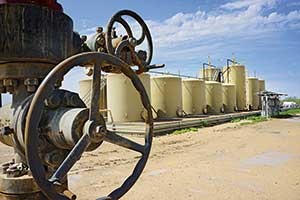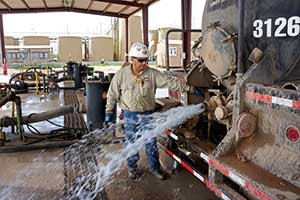Midstream options let large propane retailers diversify business, increase cash flow

A well at the Sable Environmental LLC facility in Catarina, Texas, is in the foreground, while saltwater tanks are in the background. Ferrellgas acquired Sable in 2014, marking its entry to midstream.
Photo courtesy of Ferrellgas
Propane production is up across the United States, and it’s expected to grow steadily over the next 10 years. Natural gas liquids (NGLs) production is up, as well, and it too is expected to increase over time.
The surge bodes well for U.S. energy. But added production alone in the booming shale energy era will not ensure propane and NGLs get where they’re needed. A more sophisticated infrastructure system of transportation and storage assets is a must, says ICF International’s Mike Sloan, if the oil and gas industry is going to be most effective in the coming years.
Those assets must be developed, though. And that’s where a number of propane companies are finding new business opportunities.
“There is so much change going on in the energy industry and so much growth in different areas that it provides a range of opportunities,” says Sloan, principal at the Virginia firm. “It’s bigger than anything we’ve seen in a really long time.”
Because existing infrastructure cannot support the growth of propane and NGLs, Sloan expects the stream of investments in midstream assets to continue. Many of the opportunities are transportation related, he says, connecting facilities to streamline the movement of propane and NGLs. Processing and storage assets are other opportunities within the midstream sector.
“With oil prices being down, a lot of the companies that have been developing the infrastructure and markets are looking for ways to increase cash flow and reduce debt if they’re reliant on revenues from the oil industry,” Sloan says. “There’s an opportunity to pick up assets in a less expensive way than we would have seen last year or the year before.”
The attraction
A select number of propane retailers with the capital to buy midstream assets are among those making investments – or at least exploring the midstream arena.
Take Ferrellgas, which ventured into midstream about a year ago when it acquired Sable Environmental LLC, a company that provides saltwater disposal services for oil and gas companies throughout the Eagle Ford shale in south Texas.
According to the Railroad Commission of Texas, the saltwater produced with oil and gas or flowing back during the hydraulic fracturing process must be disposed in a manner that does not pollute surface or subsurface waters.

A Sable Environmental LLC employee performs a splash test, which Ferrellgas describes as a visual check of the saltwater level versus oil on all trucks that come in before saltwater is pumped out. Photo courtesy of Ferrellgas
Ferrellgas invested in this area with its $125 million deal to purchase Sable, which has a permitted capacity of 150,000 barrels a day at its active saltwater disposal wells, in rock formations similar from where the water came. The deal sparked the development of a midstream division within Ferrellgas.
“While at first glance the Sable addition might initially seem somewhat outside the norm for us, we view it in very much the same way we view the acquisition of a traditional retail propane company – as an expansion of our strategic footprint that will benefit us over the long term,” says Scott Brockelmeyer, vice president of marketing and media relations at Ferrellgas. “We’re proud to have entered the midstream. There is significant opportunity there and diversification is smart business.”
Ferrellgas did not target saltwater disposal for its entry into midstream, Brockelmeyer adds. Instead, the company evaluated the acquisition opportunity, making the decision to act.
Later in 2014, Ferrellgas acquired two saltwater disposal wells in the Eagle Ford shale from C&E Production LLC. Ferrellgas now has eight saltwater disposal wells in that region, as well as several permits to expand.
“Saltwater disposal will never go away as long as the holes are dug,” Brockelmeyer says. “It’s a long-term business – not a one-hit wonder.”
Sloan agrees these businesses are not one-hit wonders. Based on the propane and NGL growth he’s projecting, he sees midstream assets at minimum as viable 15-to-20-year entities.
“We’re in a growth curve right now,” Sloan says. “We’re growing faster than we will be five years from now or 15 years from now. Even though the growth will slow down, the number of business opportunities is not going to disappear. Right now is the time to be building a business and investing in new infrastructure. That infrastructure will be used and profitable, if done right, for 15 to 20 years – and probably a lot longer than that.”
Energy Distribution Partners, which sold 21.2 million retail propane gallons in 2014, is not currently involved in midstream. The company’s top official sees a great opportunity in that space, though.
“The propane industry and, specifically, the entire natural gas liquids stream has infrastructure that all needs to be re-plumbed because it’s going in the wrong direction,” says Tom Knauff, CEO of Energy Distribution Partners. “Product used to move from the Gulf Coast and Kansas to the locations producing it. Now, [propane and NGLs] are being produced in those locations, and they need to go back there at some point.”
According to Knauff, Energy Distribution Partners’ short-term goal is to acquire or develop midstream assets, such as transportation and storage infrastructure.
“It’s a big opportunity, and we have to start small,” he says.
Propane retailers aren’t capable of building a pipeline on their own, Knauff says. But the combination of retailers and other companies collectively investing in midstream assets could significantly alter propane and NGL infrastructure.
“The big companies like Kinder Morgan, Enterprise [Products Partners] and Magellan [Midstream Partners] are bigger than the whole propane industry,” Knauff says. “Some of their individual assets are bigger than the propane industry.”
So propane retailers are taking a smaller, more gradual approach as they explore midstream opportunities.
What’s driving demand?
Master limited partnerships (MLPs) and other propane retailers will likely get involved in midstream over the next few years, based on the recent interest and movement in this area from companies such as NGL Energy Partners, which has significantly built up its midstream business.
NGL Energy Partners was formed in October 2010 from a merger between Illinois propane retailer Hicksgas and Tulsa midstream and wholesale company NGL Supply. The company went public in 2011.
NGL Energy Partners CEO Michael Krimbill didn’t want the new MLP to be a pure retail propane play, though. He wanted a midstream and wholesale component that would help meet the developing shale plays for years to come.
NGL Energy Partners’ midstream division, which launched with three terminals, grew to 18 after acquiring SemStream LP and North American Propane. Its midstream division continues to grow, focusing on gas gathering, processing, transportation and storage.
In 2014, NGL Energy Partners delivered 150 million retail propane gallons and 1.25 billion wholesale propane gallons.
“As you grow, you want to have an investment grade rating from the rating agencies,” says Krimbill, in a 2012 interview with LP Gas. “To get there, retail propane needs to be 25 percent or less of your total business. You need to grow your midstream. It takes longer to put in place, but it has higher rates of return.”
What about the current lack of growth in retail propane? Is that driving investments in midstream, as well?
“Maybe the opportunities in the propane retail space are a little crowded,” Sloan says. “There have been a number of major acquisitions over the last few years, but there hasn’t been a lot of growth in terms of volume. Companies are looking for different ways to continue to grow and expand.”
Knauff, on the other hand, doesn’t believe a lack of growth in retail propane is driving retailers upstream.
“That may be drilled into people’s minds that that’s what’s happening, but it’s not in my mind,” Knauff says. “I think there’s a lot of misunderstanding about growth. Gallons growth is all the [propane] industry can talk about. You can’t talk about margin that much. Most of the big volumes for propane that have been lost were pretty thin-margin volumes anyway.”
Knauff attributes the interest in midstream assets to other factors.
“The reason you see big propane getting into it is investors know they have reduced commodity exposure,” he says. “There’s a high level of recurring yield and it’s a secure investment that’s non-volatile. The more of those midstream assets you have, the less volatility you have.”
An investment in a midstream asset requires a lot of capital, Knauff adds, and that’s why a number of midsize to large propane companies have single assets.
“They’ll have a Y-grade terminal or a small terminal – something like that,” he says. “It will never be something that the average small to medium retailer gets into. The capital is too big. A small midstream transaction is a huge transaction.”
2014-15 transactions
Here’s a look at the movement LP Gas kept tabs on over the last year, with the acquiring company in bold:
Blossman Gas
■ Blue Flame Gas – Powder Springs, Ga.
■ Dade Gas – Trenton, Ga.
■ Dixie Gas – Richmond, Va.
Brinly-Hardy Co.
■ Louisville Tin & Stove Co. – Louisville, Ky.
Buster Brown Propane
■ Ferguson Propane – Cleveland, Texas
Chesapeake Utilities Corp.
■ Gatherco Inc. – Orrville, Ohio
Crystal Flash
■ Brenner Oil Group tank truck division – Holland, Mich.
Energy Distribution Partners
■ Quality Propane – Burnsville, Minn.
Enterprise Products Partners LP
■ Oiltanking Partners – Houston
Ferrellgas
■ Kaw Valley Propane – Topeka, Kan.
■ Sharp Propane – Bastrop, Texas
■ Viking Propane – Madison, Calif.
■ Wise Choice Propane – Mount Vernon, Ohio
Gibson Energy
■ CalGas Inc. – Calgary, Alberta, Canada
■ Stittco Energy Ltd. – Calgary, Alberta, Canada
Hennessy Capital Acquisition Corp.
■ Blue Bird Corp. – Fort Valley, Ga.
JP Energy Partners
■ Southern Propane Inc. – Houston
Lehr
■ EnviroGard
MFA Oil Co.
■ All Propane Inc. – Murfreesboro, Tenn.
■ Basin Propane Systems – Vernal, Utah
■ Brown Propane – Neosho, Mo.
■ Cunningham Propane – West Helena, Ark.
■ Georgia LP Gas Co. – Manchester, Ga.
■ Home Service Oil Co. – Poplar Bluff, Mo.
■ New Hampton Propane – New Hampton, Mo.
■ PB’s Propane – West Plains, Mo.
NGL Energy Partners
■ TransMontaigne Inc. – Denver
Paraco Gas
■ Gateway Propane – East Carondelet, Ill.
■ Kosco’s propane division – Hudson Valley, N.Y.
■ North Carolina Propane Exchange – Thomasville, N.C.
Power Solutions International
■ Buck’s Engines – Oklahoma City
Premier Cooperative
■ Charter Fuels – Lancaster, Wis.
Proulx Oil & Propane
■ J.A. Bourque & Sons – Manchester, N.H.
Rymes Propane & Oil
■ Fred Fuller Oil & Propane – Hudson, N.H.
Targa Resources
■ Atlas Pipeline Partners LP and Atlas Energy LP
TerraVest Capital Inc.
■ Signature Truck Systems Inc. – Flint, Mich.
ThompsonGas
■ Apex Propane Service – Apex, N.C.
■ Ethco LP Gas – Kenly, N.C.
■ Little River LP Gas/Ellco Industries – Gastonia, N.C.
■ Tri-State Gas – Clinton, Ky.
UGI Corp.
■ Total’s French LP gas distribution business – France
Worthington Industries
■ dHybrid Systems – Salt Lake City
Editor’s note: Other transactions have taken place over the last 12 months, but some propane industry companies have chosen to keep their acquisitions private. Submit acquisitions news to Editor Brian Richesson at brichesson@northcoastmedia.net.
















